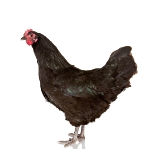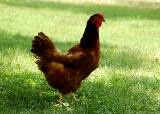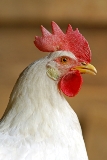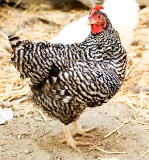Hearing the clucks and murmurs of a contented hen happily scratching for grubs and insects in the leaf litter under a tree or hedgerow can be one of the more satisfying moments of small farm living.
Being able to collect an egg from her each day is surely the icing on the cake.
Poultry can make great family pets and are ideal table scrap recycling units. They're great soil aerators and their poo is excellent for composting. If you're up to the task, they can make great soup once their use-by date has been reached.
Choosing chicken breeds
In choosing a breed, you really want to decide if their services are required for egg production, meat, or both. You may also want to consider their temperament, as some breeds are better around children than others.
Happy hens enjoying the luxury of scratching up bugs and other delicacies for their dinner.
Common chicken breeds suitable for small farms
| Breed | Description | Temperament | Egg-laying characteristics | Meat-eating potential |
| Black Australorp |  |
|||
|
Aussie's national breed. |
Friendly, calm, great personality. Great family pet. Great mothers. |
Good layer. Light brown egg. | Good, heavy body. Good meat production. | |
| Rhode Island Red |  |
|||
| Rich red/brown feathers. | Placid, mixes well with other breeds. Good family pets. Hardy constitution. Good for cross-breeding. |
Light brown egg. Good layer. | ||
| White Leghorn |  |
|||
| Tall, slender white bird with a beautiful red comb. |
Tend to be flighty and nervous. Good for cross-breeding with hens of other breeds. |
Large white eggs. Good layer. Does not get broody. |
Not recommended. | |
| Light Sussex |  |
|||
| Attractive. Red, white, light and speckled varieties. Favoured by fanciers. |
Brown eggs.Can get broody. | Excellent table bird. | ||
| Plymouth Rock |  |
|||
| Large, alert bird with yellow legs and beak. Favoured by fanciers. |
Brown eggs. Can get broody. |
Good dual purpose bird. |
Purchasing poultry
Chickens can be purchased at any stage of their life, even as incubated eggs about to hatch. It is probably better to purchase them as hatchlings that have been sexed unless you're prepared to have half of them grow into roosters!
Poultry intended for egg laying are probably best purchased as female pullets aged 14 to 16 weeks.
After settling in, these will then commence laying by about 18 weeks of age. It pays to purchase your chickens from professional reputable suppliers. The birds will then have been correctly sexed and from day one will have been vaccinated and wormed against prevalent diseases and internal parasites. Sourcing poultry from markets or similar where their age and origin is unknown invites unwanted pests and disease into the flock and property. Purchasing old commercial layers is invariably false economy as the best of their days as layers is probably behind them.
Egg laying potential and hen lifespan
While it is okay to pick and mix breeds together when purchasing, avoid mixing their ages. Chickens tend to establish their pecking order when young and introducing younger birds into an established flock is only likely to cause all of them unnecessary stress and grief.
Poultry hens typically have a lifespan of 9 years and most breeds tend to lay well for only their first three years of life. Exceptions however can be found in many of the pure-bred lines like the Australorp, Rhode Island and Leghorns. These will lay eggs well for as long as they live – often 10 years or more – and produce only in the order of 5 to 8% less than those of the cross-bred hybrid lines. You can expect a good hen to lay around 4 to 5 eggs a week and typically around 200 eggs per year.
Poultry laws and restrictions
Keeping poultry in Australia is subject to state and territory law, which is often amended further by local government. The best source for learning about your responsibilities is likely to be your local council's website. Within city limits, numbers are typically restricted to 20 birds and note: no roosters are allowed! The rules and restrictions are generally reasonable and common sense. Typically they'll include things like ensuring bad odours are kept at bay, vermin are controlled and poultry housing structures and pens are not built too close to the neighbours. In rural settings, the rules for non-commercial operations are likely to be less stringent than within city limits, for example allowing greater numbers and roosters to be kept. Again your local council is likely to be the best source of information on these.
Commercial production
Commercial poultry operations however are subject to several more laws, rules, codes and regulations, which originate from Commonwealth, state and local government levels. Although a detailed analysis of these fall outside the scope of these articles, if you are considering a commercial poultry operation, be aware that commercial poultry farming is traditionally a much regulated industry and there will be a lot that you will need to make yourself aware of. Supplying existing commercial egg and meat processors and distributors is likely to be very difficult for newcomer small-farm operations. The poultry industry tends to be a very vertically integrated one where the processors and distributors have a great deal of control over who supplies them, and how they do it. This does not mean it will be impossible for a small farm to break into some niche supply arrangements of their own, but if you do find something that looks promising, a talk with someone from the local council who is knowledgeable on the rules and regulations would be a sensible first step.
Where to from here?
For further information on choosing a chicken breed we recommend you purchase a copy of Poultry Agskills. This book provides a basic guide to some of the skills and practices of poultry production. The next article in this series on poultry for small farms will focus on their housing.
 |
The author, Roger Martyn has spent 20 plus years working in agriculture and horticulture since graduating from Massey University with an Agricultural Science degree. He has helped many farmers improve their farm productivity and profitability as well as often increasing the enjoyment they got out of farming. |



